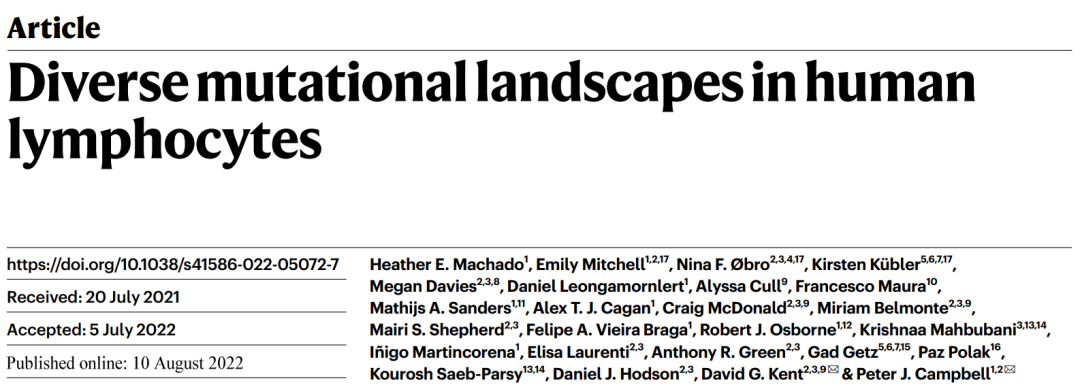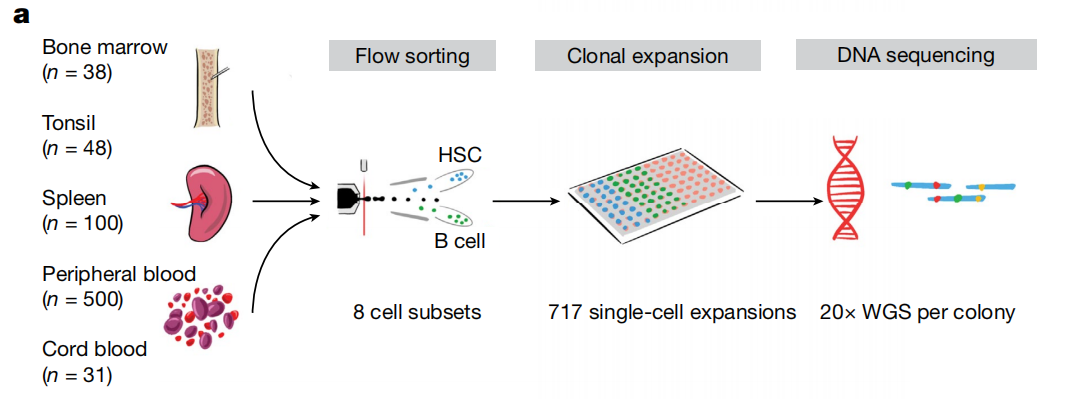Diverse mutation landscape of human lymphocytes
Author:Bioart biological art Time:2022.08.25

Written article | Thanksgiving
#immunity#
The adaptability of the immune system depends on the mutations of immune cell receptors, so as to produce a variety of antigen to ensure that it can have effective immune response to foreign antigen in a variable environment. T cells use the lack of RacombinaSeActivating Gene (RAG) to produce functional T cell receptors (TCR); B cells use the same strategy to use RAG to heavy and light and light chain of immunoglobulin (IMMUNOGLOBULIN, IG) The chain is re-arranged, and then uses activated inductive cytosidase (Cytidine Deaminase (AID), AID) to catalyze to produce somatocyte superchase (Hypermutation SHM) and category conversion recombination (CSR) to further enrich the receptor Diversity [1]. However, genomic editing off -targets in lymphocytes can bring mutations and cause lymph malignant tumors, including lack of mutations in RAG mediated in acute lymphocyte leukemia [2]; somatocyte super mutation of AID -mediated in large B -cell lymphoma [ 3]; and category conversion reorganization in multiple osteoma [4]. At present, researchers have done a lot of research on mutations in lymph malignant tumors, but the study of mutation loads of normal lymphocytes is not comprehensive. At the same time, lack of B cells and T cells, childish cells and memory cells, normal lymphocytes and malignant villain The quantitative and comparison of lymphocyte genomic diagrams.

On August 10, 2022, a researcher at Peter J. Campbell, the Institute of Sangqiao University of the British Institute and Cambridge University, and Professor David G. Kent published an article entitled DIVERSE Mutational Landscapes in Human Lymphocytes in Nature. The variety of human lymphocytes was drawn, compared with B cells and T cells, NAITVE cells and memory cells, as well as normal lymphocytes and malignant lymphocytes, and found that all lymphocytes and asia Dip mutation and structural variation, the mutation load of memory cells is higher than that of naive cells, while T cells accumulate higher speeds in the entire life, and the desertencies effect during immune cell differentiation account for about half of the mutations related to the differentiation of lymphocytes.

First of all, the researchers collected bone marrow, spleen and blood samples from four ages at the age of 27-81, tonsil tissue from two 4-year-old children, and umbilical cord blood samples from neonatal. After that, the researchers conducted a cell flow -type and developed an in vitro single -cell lymphocyte amplification culture plan for cell amplification. The whole genome is sequensed, with an average depth of about 20 ×.

Figure: Experimental Design Schematic diagram
Studies have shown that Single Nucleotide Variants (SNV) (SNV) and variations of insertion or lack of differential variations are mainly affected by age and cell types. The mutation of lymphocytes is accompanied by the rolling of the age gear to increase at a constant rate, and the variable rate of each lymphocyte sub -group is different. In addition, some lymphocytes such as alkaline substitution in memory cells have increased significantly, and the mutation may come from mutations obtained in the process of differentiation. Researchers have also found that the differences in inter -cell mutation load have also increased significantly with differentiation.
Memory B cells have a high incidence of depairing targets during the GERMINAL Center Reaction, and the average target IGHV mutation is obtained in the entire genome. Another feature of the reaction of the birth center is that the telomerase activity in B cells increases. The researchers estimate the telometer length from the genome sequencing data of the dataset. The telomeres in HSPCS, T cells, and childish B cells decreased by 30-50 BP [5] each year. On the contrary, the telomeres of memory B cells increase with age and mutation.
In many physical tissues, the mutation of cancer is usually higher than the normal cells from the same tissue [6]. A long -term controversy in the cancer model is whether the tumor needs additional mutation process to obtain sufficient carcinogenic conversion drive mutations [7] Essence In order to solve the problem of lymph malignant tumors, researchers compared the genome of normal B cells and T cells and the genome of 8 cases of blood cancer, and found that they had similar effective sequencing coverage, and the structural variation of all lymph malignant tumors was the rate of variation of the structure variation of all lymphoma tumors. Higher than normal cells. The increase in point mutation may be due to the increase in the activity of the mutant process that exists in normal cells, or different cancer -specific mutation processes occur. Most mutations in all B -cell malignant tumors can be attributed to the same mutation process in normal memory B cells, and the proportion is roughly similar. These data show that the process of generating point mutations in normal lymphocytes can produce sufficient body cell mutations and develop into many types of lymph -like malignant tumors. This shows that the malignant conversion of lymphocytes is related to the emergence of the unstable genome of cancer, which has generated genomes with a larger scale. Compared with the mutation between people, the variation between cells and cells is much larger, which indicates that compared with the genetic mutation of mutation rate, environmental factors (such as infection, inflammation, and skin residence) pairing lymphocyte genome groups The impact is greater. DNA damage caused by ultraviolet radiation and other sporadic mutation processes have produced hundreds of mutations in some memory cells. The mutation load and characteristics of normal B cells are roughly similar to the mutations in many B cell cancer, which indicates that the malignant conversion of lymphocytes produces the same mutation process in the normal development of life.
In summary, this study has a deeper understanding of the mutation of healthy lymphocytes and the process of leading these mutations, and has established the relationship between aging and lymphatic mutation. In addition, future research needs to further explore how much these mutations and processes are between different organizations in order to investigate whether they provide ways for future development treatment methods.
Original link:
https://www.nature.com/articleS/S41586-022-05072-7
references
1. Tarlinton, D. & God-Jacobson, K. DIVERSITY AMONG MEMORY B Cells: Origin, Consequences, and Utility. Science341, 1205–1212 (2013).
2. MULLIGHAN, C. G. Et Al. Genomic Analysis of the Clonal Origins of RelapSed Acute Lymphoblastic Leukemia. Science 322, 1377–1380 (2008).
3. Pasqualucci, L. Et Al. Hypermutation of Multiple Proto-Oncogenes in B-CELL DIFFUSE LARGE-CLL LYMPHOMAS. Nature 412, 341–346 (2001)..
4. Walker, B. A. et al. Characterization of IGH Locus Breakpoints in Multiple MyLoma Indicates a Subset of Transitions Appear in Pregerminal Center B Cells.
5. Vaziri, H. Et Al. Loss of telomeric DNA During aging of normal and trisomy 21 human lymphocytes. Am. J. Hum. 52, 661–667 (1993).
6. Brunner, S. F. et al. Somatic Mutations and Clonal Dynamics in Healthy and Cirrhotic Human Liver. Nature574, 538–542 (2019).
7. TOMLINSON, I. P., Novelli, M. R. & Bodmer, W. F. The Mutation Rate and Cancer. Proc. Natl Acad. Sci. USA 93, 14800–3 (1996).


- END -
Fermi estimates in the application of risk control scenarios

In the construction of risk control, some tools need to be used to help business d...